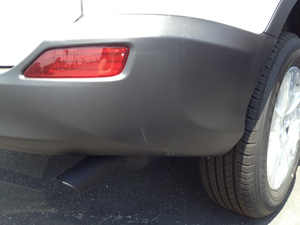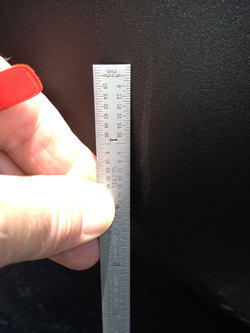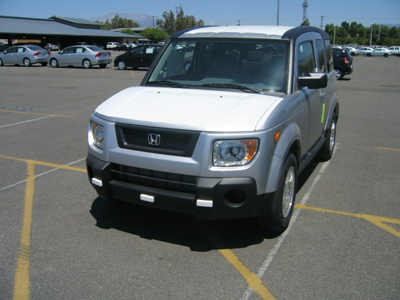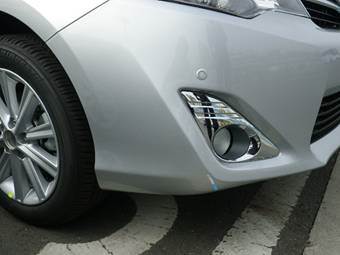Carmakers are concerned about finding and repairing damage, but to prevent repeat errors it is necessary to have visibility of damage across the supply chain, and to listen to the story behind each and every incident.

Stories from out in the field reveal that manufacturers who have successfully lowered damage rates appear to be those who have closely monitored outbound operations and worked with all parties of the supply chain to understand how to prevent damage. Transparency is one of the most important factors, agree executives from carmakers and third party companies.
Executives from American Honda, for example, emphasise improving communication throughout the supply chain. Gary Cooper, assistant manager for automobile logistics planning, explains that processors inspect all vehicles at origin points such as at ports or plants, before releasing them into the supply chain. At this stage, any ‘class one’ damage – which is damage that is relatively minor – is repaired to full factory specifications before shipment. Class two damaged vehicles, which are those that have sustained more extensive damage, are also repaired to factory specifications but then exit the supply chain and become company vehicles or used cars that are handled accordingly. Even higher classified damaged vehicles are salvaged or destroyed and never enter the market.
In recent years, Cooper says American Honda has found that greater levels of oversight employed throughout the entire finished vehicle distribution network have contributed to reducing its national damage frequency from 0.3% to 0.2% – a 33% reduction. The company now places a strong focus on communication with each party that handles its products. This includes issuing a monthly rolling '24 report card' covering topics like damage frequencies, claim aging and rankings for each claim. American Honda also holds bi-weekly conference calls with targeted vendors to cover countermeasures, best practice and claim-by-claim reviews.
"Additionally, whenever we spend time meeting with a vendor, we cover vehicle-handling practices and any recent damage incidence of note and review their damage frequency and outstanding claims," says Cooper.
"We make sure our vendors understand we are continuously concerned with how they handle vehicles and process damage claims. We also provide access to the same data and information we see to enhance visibility of the process. We do not want them comfortable with being in the bottom percentages of performance," he adds.
Toyota’s incremental improvements
 Toyota has been working on eliminating scuffs on bumpers, which can be a costly damage. Pictured above is a scuff on a Rav4 bumper, and its measurement (left)
Toyota has been working on eliminating scuffs on bumpers, which can be a costly damage. Pictured above is a scuff on a Rav4 bumper, and its measurement (left)
In the US, Toyota also performs vehicle inspections at all hand-off points in the supply chain.
Who performs these inspections varies depending on each situation, and is usually either Toyota associates, third party inspectors at Toyota’s request, as well as joint inspections between Toyota and its logistics partners.
"This way, if any damage is found, it’s clear who is responsible, so we hold them accountable, create a damage claim and begin working together on countermeasures to prevent further damages from occurring," explains Grant McGlynn, national manager of supply chain quality at Toyota Logistics Services.
When damage is found, the vehicle is stopped at the point in the supply chain where a damage survey ticket is written before the vehicle is sent for repair at a Toyota certified facility. According to McGlynn, Toyota is always working with its logistics partners to identify damage trends and take corrective action.
"We seek incremental improvements. We have recently created a new supply chain quality department within Toyota Logistics Services,” says McGlynn. “Up until now the quality function was in silos in our three transportation departments – rail, highway and marine. The new quality group will now collaborate with all transportation departments and logistics partners to eliminate damages from assembly plant to customer."
One of the many projects that Toyota has been working on recently in reducing damage, for example, is the elimination of scuff marks (pictured above) on unpainted exterior plastic surfaces. “Since these materials are easily scuffed, it’s an issue we’re addressing across our entire supply chain,” says McGlynn.
Digging at the root cause of damage
Tokio Marines Claims Service (TMCS) oversees claims settlement for a number of Japanese carmakers. The company relies on networks of vehicle surveyors and damage appraisers to attend vessel and distributor compounds to assess claims and report damage through its proprietary web-based claims portals, according to Timothy Doonan, senior vice-president at the company’s marine claims division.
The company's operational process begins with identifying damage, estimating the repair allowance and uploading damage survey or appraisal results to TMCS via the web before verifying damage and paying the distributor for repairs. Following this, the TMCS system compiles damage details to create statistics of damage frequency and severity that allow the company to communicate frequent trends to carmakers by location, model, area, type, and cause in a standard format that can be compared to the results of the other global markets.

One example of how this system has been used to improve processes occurred after repetitive scratch and gouge damages to the lower front bumper of one specific model vehicle were noted at multiple destinations from a single plant of origin. After identification of the damaged area, Doonan says that TMCS performed a tracing study and followed the logistics trail to find the root cause at the original loading point, where equipment was found to be unevenly worn or bent creating an excessive angle for loading the vehicles.
"When a vehicle approached the ramp at normal speed, there was contact with the bumper causing damage. The remediation was to replace the ramp with a new component and check all other equipment for a similar defect," says Doonan."The repetitive damage was eliminated," he adds. "There are numerous other examples for reducing damage from wind exposure in open storage,such as hail nets or evacuation plans that are part of risk management.”

For Doonan, the main lesson is to be vigilant about monitoring damage trends and keeping records before actively visiting logistics operations to see what is happening first hand. This direct experience has helped the company to gather detailed knowledge about damage occurrence and mitigation. Key examples include the fact that, although loading speed contributes to the severity of damage, it is not the root cause – and that, although tape, foam, or plastic-edge guard protection may have minimised bumper damage, it would have come at a significant cost.
"We communicate these activities and results upstream with OEMs regularly through monthly meetings and with special loss control projects to monitor operations and to continuously improve the results towards a goal of zero damage," says Doonan.
He adds that TMCS communicates downstream to logistics providers with monthly reports of claims data for which they are responsible. “The net result is awareness of damage prevention throughout the logistics chain,” he says.
Faster processing times
American Honda recently hired Tokio Marine Claims Service to conduct an audit of the top claim filing dealerships nationwide to check for conformance to policy and to better understand why some dealers write more claims than others. Cooper describes how this entailed several American Honda dealer site visits and walkthroughs of the vehicle delivery process.
"We were able to correct some inspection errors that misclassified warranty conditions as transportation damage," he says.
Another important focus for the company this year is to reduce the time it takes to process claims. Cooper points out that the national average currently stands at 33 days per year, a figure that Honda would like to improve by at least 10%. One initiative begun this year is to move vendors to automated cheque handling (an automated payment system) for claims they ultimately pay, a move which Cooper says can save a week or more of process time over cheques submitted by post.
"We have about 80% vendor participation so far with excellent results," he adds.

"This is important in that if a vehicle is damaged the claim is resolved, costs are recovered and the vehicle is repaired quickly,” says Cooper. “This keeps the asset dwell at a minimum and puts the vehicle back on the road to being sold with a minimum loss of time.”
The company is also in the midst of a 15-month study covering the impact of shipping vehicles without a thin plastic wrap guard that has been used for decades. It began with one model last November and throughout the year has added more models from other plants until reaching a point where all US- and- Canadian-built Hondas are shipped without the wrap guard.
"Basically, volume is up and damages are down on the horizontal surfaces we previously covered with plastic wrap. The trial will soon begin including Acura products as well," says Cooper.
Sometimes simplest is best
Another inspection company that reports on damage is Alliance Inspection Management (AIM). According to Bob Clucas, chief operating officer, the aim is to use members of a field logistics network to identify damage and distribute reports relating to liability. These reports are often distributed via email and posted on the company's website, but Clucas says that OEMs also use electronic notification to contact its field service manager dispatch system, which has a diary system that alerts staff if assignments are open or need following up.
This process begins with receipt of the assignment, along with the VIN and location, before the collection of particulars on vehicle condition and cause of damage. Cover sheets with facts regarding liability and cause, and estimates for repairs, are then completed prior to verification of repairs.
"One manufacturer we work with discovered how much time and money they were losing with vehicles sitting at body shops,” says Clucas. “To reduce time they created a system that monitors each segment of the process, taking input from AIM from the time of the incident, to completion of repairs and then through the authorisation for reshipment. Weekly report monitoring calls are also used to hold responsible parties accountable.”
With an emphasis on reducing transit time and supply chain costs, AIM also worked with a trucking company to notify them immediately of the vehicle and yard location of units returning from repair, which Clucas said removed at least a day from the process.
"Just simple communication went a long way,” affirms Peter Daly, vice-president at AIM. “Specific lessons learned were the importance of transit time and communicating with all trading partners. There are all sorts of reports and data available but actually using it in a positive fashion to motivate and hold people accountable for improving is the key.
"It sounds so simple but the successful ones are those that create the positive team environment that brings everyone into the discussions,” adds Daly. “The best methods of communication are personal contact used in conjunction with all the electronic communication tools available to us.”
"There are all sorts of reports and data available but actually using it in a positive fashion to motivate and hold people accountable for improving is the key." - Peter Daly, AIM
Elsewhere, Marna Short, general manager of national inspections for finished vehicle logistics at Vascor Logistics, points out that each OEM has different criteria for identifying a vehicle that needs to be repaired in transit before delivery to the dealer. If a vehicle arrives at a yard and meets that criteria, the yard manager updates the vehicle’s status in Vascor’s damaged vehicle operations (DVO) system via the web. Once the estimate is complete, the status is updated again and the vehicle moved to the repair facility; once the repair is complete the status is updated and the vehicle is scheduled to be moved back to the yard to continue on to the dealer.
"This DVO system is an operational improvement over our past process where everything was tracked manually on an excel spreadsheet," says Short.
Eliminating ‘missed on inspection’
Looking ahead, Cooper believes that the industry should create more openness, particularly in the minor damage reporting process. "I mention minor damage because the cause of major damage is almost always known and reported,” he says. “As an OEM Honda will analyse damage data and focus on causes that countermeasures can be developed for. But there is no countermeasure for 'unknown causes'."
Honda's discussions with vendors show that a common explanation for damage is missed on inspection, and Cooper says that the carmaker ends up taking on liability because of the oversight. However, although he admits that better inspections would help, he is keen to stress that inspections do not in themselves provide an effective countermeasure. In his view, 'missed on inspection' statuses shield vendors at the front and middle of the delivery process when damage is later missed or improperly recorded. As a result, the ability of the OEM to understand where unreported damage occurs is then limited by the inspections that follow it, and represents a hidden incentive for damage to be passed along to the next party.
"We need to have each vendor report all damage that it causes or discovers,” says Cooper. “That would allow for proper matching of liability as well as provide a target for process improvements. Historically this data remains with the vendor unless it is needed to disprove a claim. By sitting on the data, their liability may never be established. Every vendor has a policy that says if they damage a vehicle they will pay to fix it, provided of course one can prove it.”
 OEMs want to be even more vigilant in identifying damage to avoid liability being passed on to them in the event that something was missed in the inspection process
OEMs want to be even more vigilant in identifying damage to avoid liability being passed on to them in the event that something was missed in the inspection processFor Clucas and Daly at AIM, OEMs, logistic providers and damage inspection companies will also face challenges for handling new designs, particularly those vehicles with low clearance, where securing vehicles and detecting undercarriage damage becomes more difficult.
"New methods of securing vehicles are not tested through time and there are concerns about stress to uni-body frames that may not be immediately detected,” says Daly.
He adds that the industry needs to develop more flexible methods for conducting in-transit repairs, such as mobile repair units.
From the manufacturer perspective, McGlynn also highlights that one of the most important factors for Toyota is not only getting vehicles repaired but doing so without unnecessary delays.
"As both the US auto market and export markets continue to accelerate, supply of Toyota vehicles will get tighter and tighter,” he says. “This will put additional emphasis on getting every single vehicle repaired and back into the supply chain as quickly as possible. Most likely there’s a retail customer anxiously waiting to take delivery of that vehicle."

























![Global[1]](https://d3n5uof8vony13.cloudfront.net/Pictures/web/a/d/s/global1_726550.svgz)









